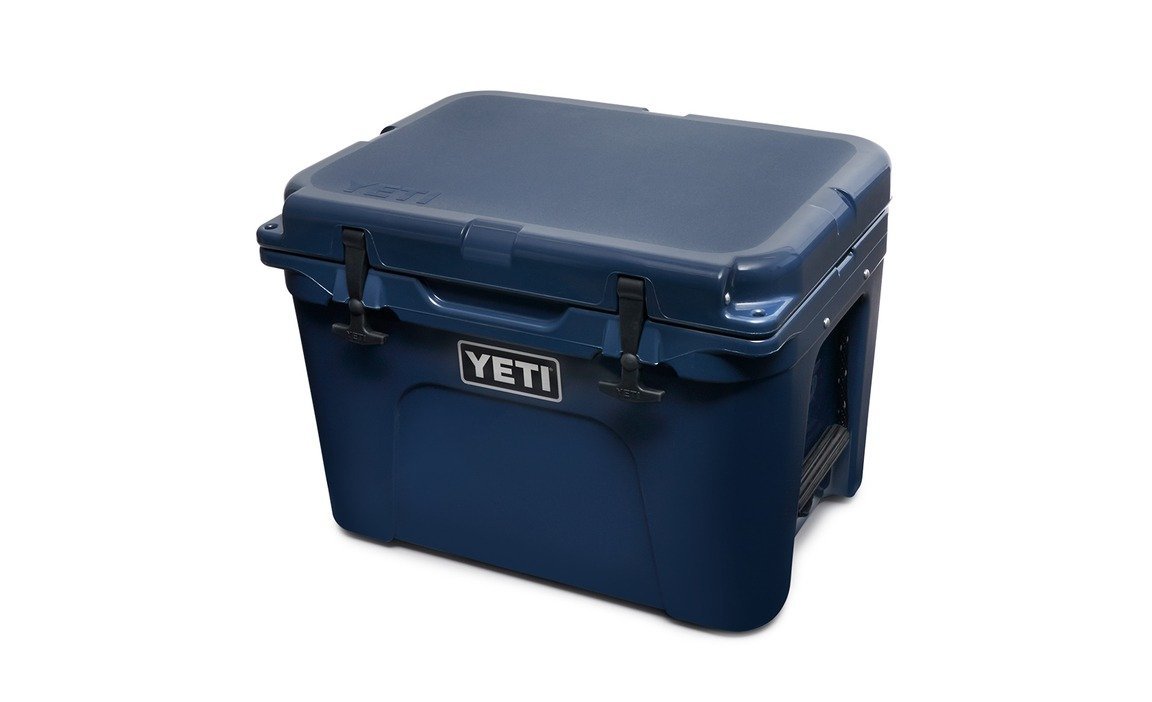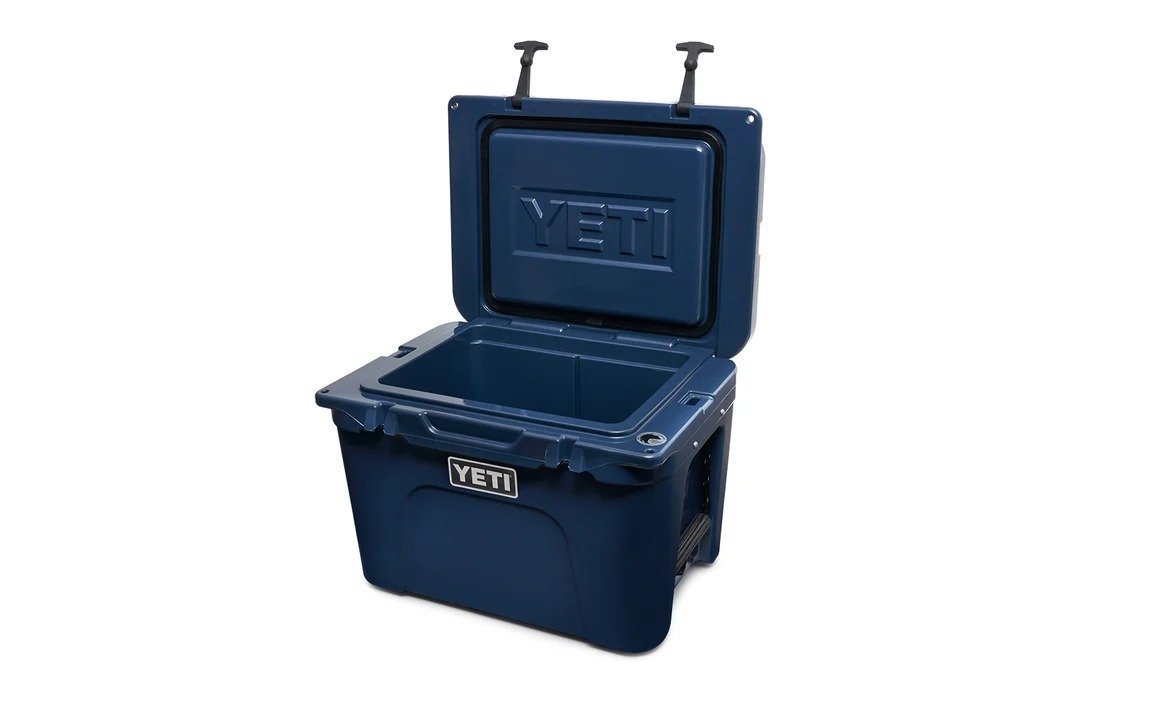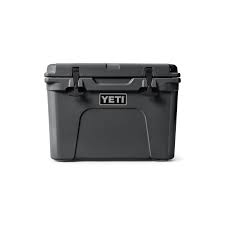Description
The YETI Tundra® 35 is the right size for personal hauls or food for a small crew. It boasts up to three inches of PermaFrost™ Insulation and a rugged rotomolded construction for optimum adventure performance. And it fits nicely in an inner tube, making it the perfect, portable cooler to take tubing down the river.
Note: This Tundra cooler comes with one dry goods basket.
- Empty Weight: 9.1kg
ICE BLOCKS Sold Separately - Takes 2x2lb Blocks or 1x4lb Blocks
https://outdoorsports.ie/products/yeti-ice-blocks
WHAT IS A YETI® TUNDRA® COOLER?
The YETI Tundra was created to solve the age-old problem of subpar coolers failing in the field. Tired of busted latches, bowed-in lids, and melted ice, brothers Roy and Ryan Seiders set out to make a superior hunting and fishing cooler — and YETI was born.
Tundra and Roadie® coolers are rotomolded, which is the same process used to create whitewater kayaks. And we designed the coolers to keep ice longer — a lot longer — by pumping them with over twice the insulation compared to most ordinary ice chests. The result is a cooler family with a dramatic durability and ice retention advantage over most any other cooler on the market.
Tundras are great for hunting, sport-fishing, camping, boating, rafting, tailgating, paddling, and barbecuing. Oh, and beer drinking, too. There’s even the Tundra 250 and 350 for commercial uses, like oil & gas, construction, and medical industries. The Roadie is BYOB’s new best friend. Roadie and select Tundra sizes are available in colour ways including classic white, desert tan, ice blue, and seasonal limited edition colours.
WHAT DOES ROTOMOLDED MEAN?
The rotational molding (also known as rotomold) process is a high-temperature, low-pressure plastic forming process that uses heat and biaxial rotation (i.e., rotation on two axes) to produce hollow, one-piece parts. The YETI cooler mold is loaded with polyethylene in powder form. The mold is then placed in a large oven while it rotates on two axes at different speeds, which helps prevent powder from accumulating in one spot. The polyethylene melts and adheres evenly to the wall of the mold. Once the polyethylene is melted, the molds are pulled out of the oven to cool. And once cool, the ice chest is then removed from the mold. It’s kind of like a huge, spinning Easy-Bake Oven that cranks out coolers instead of cakes.
The process has inherent design strengths, such as consistent wall thickness and strong outside corners that are virtually stress-free. The rotational molding process gives the coolers one-piece construction and unmatched durability.
HOW STRONG ARE TUNDRA COOLERS?
Our coolers are stronger than this grizzly and this guy. They also survived battles with fireworks, a slingshot, and a stuntman excursion. So we’d say pretty damn strong.
WHAT DOES “GRIZZLY-RESISTANT” MEAN?
Our hard-sided coolers were tested by the Interagency Grizzly Bear Committee (IGBC), a U.S. Forest Service Department of Agriculture Committee that works in both controlled and wild settings with grizzly bears.
The IGBC publishes minimum design and structural standards, inspection and testing methodology for bear-resistant containers. YETI Tundra met the IGBC requirement both in the engineered test and the live bear test. The IGBC officially approved the YETI Tundra and Roadie for use on public lands and national parks occupied by grizzlies.
HOW LONG WILL YETI TUNDRA HOLD ICE?
There are many variables that will affect ice retention, so this is a difficult question for us to answer. Variables that can affect ice retention include the ice quality, ice quantity, type of ice (crushed, block, cube, dry), outside environment, exposure to direct sunlight, etc. Which is to say there’s a lot you can do to affect the longevity of your ice.
Over the years, we’ve received many different reports from YETI users in the field regarding ice retention. Some customers have reported having ice after their two-week trip on the river while others have said that their “crappy brand X cooler will hold ice better.”
Because of the large number of variables, as well as the lack of an industry standard for measuring ice retention, claims that place a definite time (5, 10, 14 days) are often based on testing conditions and not real-life situations.
In the end, the Tundra offers up to 3 inches of polyurethane foam insulation, combined with a freezer-style sealing gasket. Beyond that, everything else is out of our control. But if you can minimise the negative variables that affect ice retention, YETI coolers can’t be beat. And we’ve compiled a comprehensive list of tips and tricks to maximise ice retention.
WHEN I THREW A BAG OF ICE IN MY TUNDRA AND MY CHEAP COOLER, THE ICE LASTED LONGER IN MY CHEAP COOLER. WHY?
A small amount of ice is not a good indicator of how well your ice chest can retain ice due to excess air space within the cooler. Excess air space hurts ice retention. To maximise ice retention, fill your cooler to the top with ice and products. In addition, if the ice chest starts out warm, a small amount of ice could initially melt faster in a YETI cooler than a thinner-walled cooler.
Best ice retention results are achieved by filling the ice chest completely with high-quality ice, which means using block ice that’s well below freezing temperature. In addition, maximum ice retention can be attained by pre-chilling your cooler. This will sufficiently cool the insulation and inside of the cooler, which helps the thick polyurethane walls work for you, not against you.
YETI Tundras have up to 3 inches of polyurethane foam insulation, which is significantly more than most common ice chests. If you use enough ice to chill the walls, YETI will most definitely outperform the competition.
WILL MY YETI KEEP MY HOT ITEMS HOT?
You might be surprised to read this, but YES. The same insulation and thick walls that keep the cooler cold also keep the heat.
WHAT SIZE TUNDRA SHOULD I BUY?
The Tundra series matches closely (usually within an inch) with many popular coolers that have been on the market for years. However, the quart size of the Tundra will be a bit lower due to the thickness of the walls and amount of insulation. Another thing to consider when choosing a size is that you want to fill the cooler with as much ice as possible, minimising air space to achieve maximum ice retention. So if you only have a small number of items to keep cool, you would want to choose a smaller ice chest and vice versa. Pretty simple idea, but check out our rough guidelines for finding the appropriate size coolers for your needs.
Roadie
- Personal, portable cooler for the truck or car
- Great for jobsite or construction lunch box
- Compatible for canoe, kayak, or paddleboard
Tundra 35
- Portable and easy to carry fully loaded
- Great backseat companion in truck, car, SUV, or 4-wheeler
- Easily fits in larger kayaks and is ideal for SUPs
- Can be used as casting platform for smaller boats
Tundra 45
- Our all-purpose cooler, ideal for overnight camping trips
- Can be carried by one person
- Fits great on off-road vehicles
- Easily used as casting platform
Tundra 65
- Great for small gatherings and weekend events
- Versatile use options, like tailgating, fishing, and hunting
- Can hold keeper redfish or a quartered whitetail deer
- Easily carried by one person
- Works as a bay boat casting platform
Tundra 75
- Perfect boat or marine cooler and is designed to fit under most leaning posts
- Can be used as seat in front of center console
- Also good for tailgates, family barbecues, or a day at the beach
HOW MANY CANS WILL FIT IN MY TUNDRA?
Using a 350ml can as the measurement, you can see how each of the Tundras stack up in terms of carrying capacity, using the recommended 2:1 ice-to-contents ratio by volume.
Tundra 35 – 20 cans
Tundra 45 – 26 cans
Tundra 65 – 39 cans
Tundra Haul – 45 cans
Tundra 75 – 50 cans
Tundra 105 – 59 cans
Tundra 110 – 65 cans
Tundra 125 – 81 cans
Tundra 160 – 100 cans
Tundra 210 – 140 cans
Tundra 250 – 155 cans
Tundra 350 – 222 cans
HOW DO I CLEAN MY TUNDRA?
For general cleaning we recommend using soap and warm water.
For a more thorough cleansing and problems with strong odors, use a solution of warm water and bleach (6:1 ratio) with a sponge or mildly abrasive rag. Odors can easily get trapped in hard to reach areas such as around the gasket and drain plug, so be sure to thoroughly scrub those areas.
For tough stains and very foul odours we would recommend cleaning your YETI with a high pressure soap spray found at a local do-it yourself car wash.




